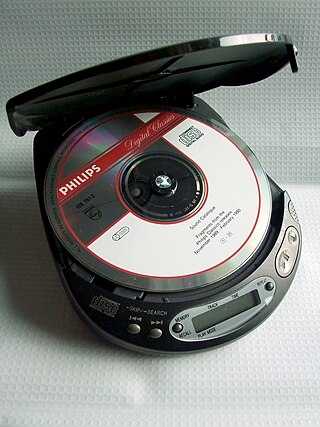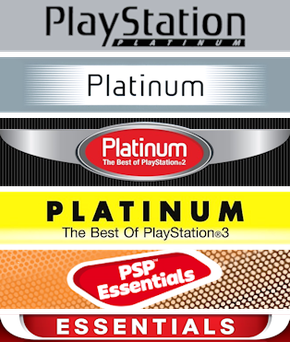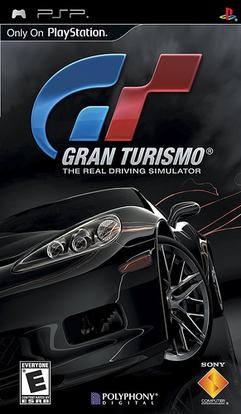
A handheld game console, or simply handheld console, is a small, portable self-contained video game console with a built-in screen, game controls and speakers. Handheld game consoles are smaller than home video game consoles and contain the console, screen, speakers, and controls in one unit, allowing players to carry them and play them at any time or place.

A CD player is an electronic device that plays audio compact discs, which are a digital optical disc data storage format. CD players were first sold to consumers in 1982. CDs typically contain recordings of audio material such as music or audiobooks. CD players may be part of home stereo systems, car audio systems, personal computers, or portable CD players such as CD boomboxes. Most CD players produce an output signal via a headphone jack or RCA jacks. To use a CD player in a home stereo system, the user connects an RCA cable from the RCA jacks to a hi-fi and loudspeakers for listening to music. To listen to music using a CD player with a headphone output jack, the user plugs headphones or earphones into the headphone jack.

In computing, an optical disc drive is a disc drive that uses laser light or electromagnetic waves within or near the visible light spectrum as part of the process of reading or writing data to or from optical discs. Some drives can only read from certain discs, but recent drives can both read and record, also called burners or writers. Compact discs, DVDs, and Blu-ray discs are common types of optical media which can be read and recorded by such drives.

The PlayStation Portable (PSP) is a handheld game console developed and marketed by Sony Computer Entertainment. It was first released in Japan on December 12, 2004, in North America on March 24, 2005, and in PAL regions on September 1, 2005, and is the first handheld installment in the PlayStation line of consoles. As a seventh generation console, the PSP competed with the Nintendo DS.

Essentials is the Sony PlayStation budget range in the PAL region, which covers Europe, the Middle East and Africa, Australia and South Asia. It was launched in January 1997 as the Platinum range but was later renamed for PlayStation Portable, PlayStation Vita, PlayStation 3 and PlayStation 4. Similar budget ranges from Sony include the Greatest Hits and The Best labels for the North American and Japanese markets, respectively.

PlayStation Portable homebrew refers to the process of using exploits and hacks to execute unsigned code on the PlayStation Portable (PSP).
Import gamers are a subset of the video game player community that take part in the practice of playing video games from another region, usually from Japan where the majority of games for certain systems originate.

The XrossMediaBar is a graphical user interface developed by Sony Computer Entertainment. The interface features icons that are spread horizontally across the screen. Navigation moves the icons, instead of a cursor. These icons are used as categories to organize the options available to the user. When an icon is selected on the horizontal bar, several more appear vertically, above and below it. They, in turn, are selectable by the up and down directions on a directional pad.
The PSP Camera is a digital camera peripheral by Sony Computer Entertainment for the PlayStation Portable handheld video game system. In Japan, the PSP-300 was released as the Chotto Shot on November 2, 2006, and was released in Singapore in the same year. For PAL regions, it is named the Go!Cam and was released May 25, 2007. A lower resolution version, the PSP-450x, was introduced in 2009. The PSP-450x camera was released in North America bundled with Invizimals on October 12, 2010, and was also bundled with EyePet on November 2, 2010.

Gran Turismo is a 2009 racing video game developed by Polyphony Digital and published by Sony Computer Entertainment for the PlayStation Portable. The game was announced at Sony's E3 press conference on May 11, 2004, alongside the original PSP. Following five years of delays and speculation, during which it was variously known as Gran Turismo Portable, Gran Turismo 4 Mobile, Gran Turismo 5 Mobile and Gran Turismo 4.5, it made a reappearance at E3 on June 2, 2009, in playable form. It was released on October 1, 2009, as one of the launch titles for the new PSP Go. As of September 2017, Gran Turismo has sold 4.67 million units, making it one of the best-selling PSP games. On June 1, 2010, the game was re-released as part of Sony's Greatest Hits budget line of video games.

In computer hardware, a caddy is a container used to protect an optical media disc from damage when handling. Its functionality is similar to that of the 3.5" floppy disk's jacket.

Blu-ray is a digital optical disc data storage format designed to supersede the DVD format. It was invented and developed in 2005 and released worldwide on June 20, 2006, capable of storing several hours of high-definition video. The main application of Blu-ray is as a medium for video material such as feature films and for the physical distribution of video games for the PlayStation 3, PlayStation 4, PlayStation 5, Xbox One, and Xbox Series X. The name refers to the blue laser used to read the disc, which allows information to be stored at a greater density than is possible with the longer-wavelength red laser used for DVDs.
The seventh generation of home video game consoles began on November 22, 2005, with the release of Microsoft's Xbox 360 home console. This was followed by the release of Sony's PlayStation 3 on November 17, 2006, and Nintendo's Wii on November 19, 2006. Each new console introduced new technologies. The Xbox 360 offered games rendered natively at high-definition video (HD) resolutions, the PlayStation 3 offered HD movie playback via a built-in 3D Blu-ray Disc player, and the Wii focused on integrating controllers with movement sensors as well as joysticks. Some Wii controllers could be moved about to control in-game actions, which enabled players to simulate real-world actions through movement during gameplay. By this generation, video game consoles had become an important part of the global IT infrastructure; it is estimated that video game consoles represented 25% of the world's general-purpose computational power in 2007.
The PlayStation Portable system software is the official firmware for the PlayStation Portable (PSP). It uses the XrossMediaBar (XMB) as its user interface, similar to the PlayStation 3 console.
PlayStation is a video gaming brand that consists of five home video game consoles, two handhelds, a media center, and a smartphone, as well as an online service and multiple magazines. The brand is produced by Sony Interactive Entertainment, a division of Sony.

The PlayStation Portable's hardware consists of the physical components of the PlayStation Portable (PSP) and its accessories.

The PSX is a Sony digital video recorder with a fully integrated PlayStation 2 home video game console. It was released in Japan on December 13, 2003. Since it was designed to be a general-purpose consumer video device, it was marketed by the main Sony Corporation instead of Sony Computer Entertainment and does not carry the usual PlayStation branding. Initial sales were strong, with the console selling 100,000 units during its first week, thus selling out. Its high cost, however, resulted in poor sales later on, prompting Sony to cancel plans to release the PSX outside Japan. After the price had been lowered in September 2004, sales increased again.

DJ Max Fever is a music game for the PlayStation Portable developed by Pentavision and PM Studios. It was released in 2009. Although the franchise has made several appearances in Asia, DJ Max Fever is the first DJMax released in the United States and Europe. The game is a compilation of DJMax Portable and DJMax Portable 2 along with additional features. By decision of PM Studios, it is the only title in the DJMax series with a space between words "DJ" and "Max". A digital version of the game was released in 2010 on PlayStation Network, but later removed due to licensing expiration.
h.m.p. Co., Ltd., formerly known as Houyuu Media Produce (芳友メディアプロデ), is a Japanese company which is involved in adult entertainment including the production and sales of adult videos (AV) and the marketing of adult toys and sex aids.
Total Media Agency (TMA) is a Japanese adult video company located in Tokyo, Japan.














